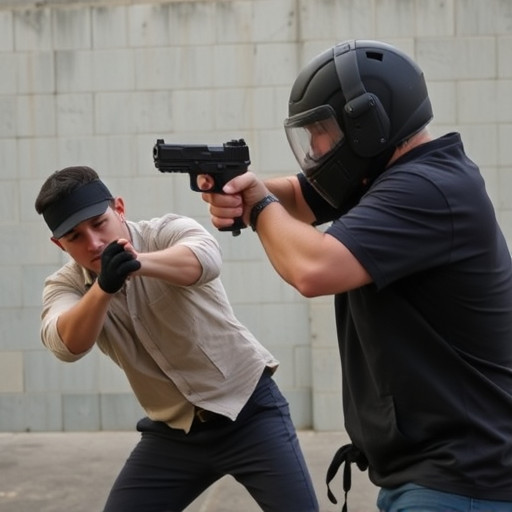Non-Lethal Stun Guns Online: Unveiling Intimidation Factor’s Truth
Non-lethal stun guns, easily accessible online, are designed to temporarily incapacitate assailants…….
Non-lethal stun guns, easily accessible online, are designed to temporarily incapacitate assailants without causing permanent harm through high-voltage electric arcs. With growing popularity and varying models available, it's crucial to navigate their safety and effectiveness, addressing myths about power, range, and one-shot incapacitation. Responsible purchasing decisions and comprehensive user guidance are essential amidst the confusing variety. Proper training is vital to understand these Electronic Control Devices (ECDs) limitations and maximize their effectiveness in real-world scenarios.
Electrical arc displays, often associated with powerful and intimidating energy, have sparked curiosity both online and offline. This article delves into two key aspects: exploring the mechanics behind these mesmerizing yet potentially dangerous phenomena and examining non-lethal stun guns, a popular online tool designed to deter threats. We navigate safety and effectiveness, debunking myths surrounding stun guns to offer an insightful guide for those seeking genuine protection in today’s world. Discover more about non-lethal stun guns online and their role as a formidable yet safe deterrent.
- Understanding Electrical Arc Displays: Unveiling the Mechanism
- The Non-Lethal Stun Gun: A Tool with an Intimidating Presence Online
- Navigating Safety and Effectiveness: Debunking Myths About Stun Guns
Understanding Electrical Arc Displays: Unveiling the Mechanism

Electrical arc displays, often seen in stun guns and non-lethal self-defense tools marketed online, are designed to incapacitate individuals without causing permanent harm. These devices operate by generating a powerful electric current that disrupts muscle control in the target, leading to temporary paralysis. The mechanism involves a high-voltage spark (the arc) that is delivered through two electrodes, typically located at the end of the device’s prongs or barrels. This arc delivers a strong electrical pulse, causing the muscles to contract uncontrollably and resulting in a brief but intense loss of mobility.
Understanding this process is crucial when considering non-lethal stun guns as a self-defense option. The intensity and duration of the electric arc are carefully balanced to ensure effectiveness without prolonged or severe damage. While these displays can be intimidating, their purpose is to disable an assailant long enough for the user to escape or seek help, rather than to cause serious harm. This distinction makes non-lethal stun guns a popular choice for personal safety advocates looking for a visible deterrent online.
The Non-Lethal Stun Gun: A Tool with an Intimidating Presence Online

The rise of non-lethal stun guns has been a significant development in personal safety tools, especially when considering their growing presence online. These devices, marketed as a means to deter and incapacitate assailants without causing permanent harm, have garnered attention from individuals seeking self-defense options. The market is now saturated with various models, each boasting different voltage levels, weight capacities, and features, all easily accessible through simple online searches.
Online platforms serve as a double-edged sword, promoting awareness about personal safety but also potentially normalizing the use of force. With just a few clicks, users can acquire these devices, often with minimal verification or training, leading to concerns about misuse and unintended consequences. The accessibility of non-lethal stun guns online presents a unique challenge in terms of regulation and education, as the sheer variety available may intimidate and confuse potential buyers, underscoring the importance of responsible purchasing decisions and comprehensive user guidance.
Navigating Safety and Effectiveness: Debunking Myths About Stun Guns

Navigating Safety and Effectiveness is crucial when discussing non-lethal stun guns, especially as their popularity grows in online platforms. Many myths surround these devices, leading to misconceptions about their capabilities and limitations. It’s important to dispel these myths to ensure both safety and effectiveness.
Stun guns, also known as Electronic Control Devices (ECDs), are designed to temporarily incapacitate a subject through high-voltage electrical discharge. They are intended for non-lethal force applications, primarily by law enforcement and self-defense enthusiasts. Online platforms often amplify unsubstantiated claims about their power and range, which can be misleading. Research indicates that while stun guns deliver a powerful jolt, their effectiveness varies based on factors like target size, distance, and physical condition. Moreover, the idea of a “one-shot” incapacitation is often overstated, emphasizing the need for proper training and understanding of these devices’ capabilities.
Electrical arc displays, as demonstrated by non-lethal stun guns, offer a powerful tool for self-defense. While their intimidating online presence and portrayal may evoke fear, understanding the mechanism and debunking myths can help users appreciate their safety and effectiveness. When employed responsibly, these devices serve as valuable personal protection tools, allowing individuals to assert control in potentially dangerous situations. Remember, knowledge is key; navigating the facts ensures a more informed perspective on non-lethal stun guns available online.


